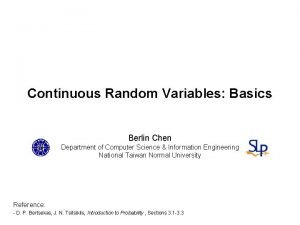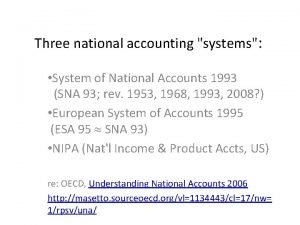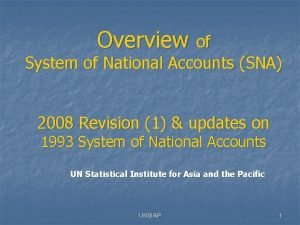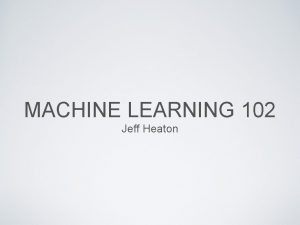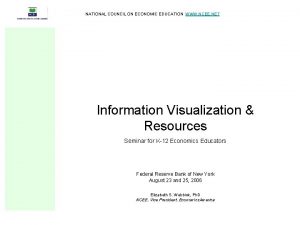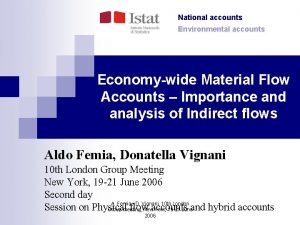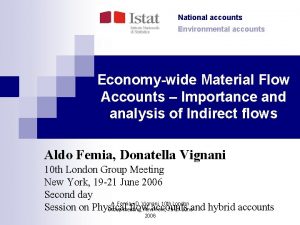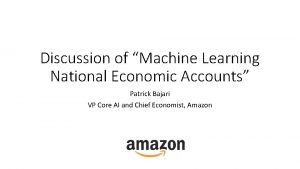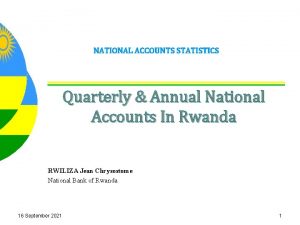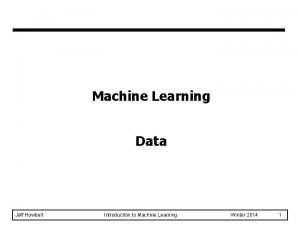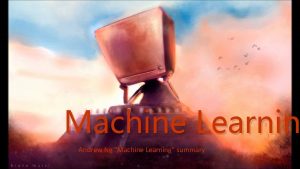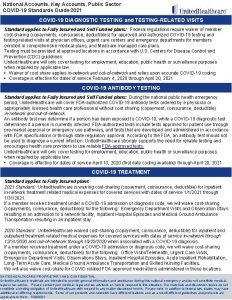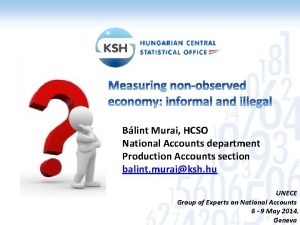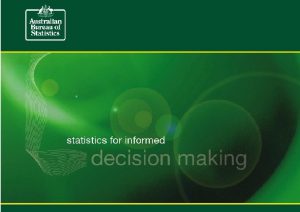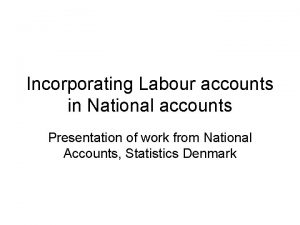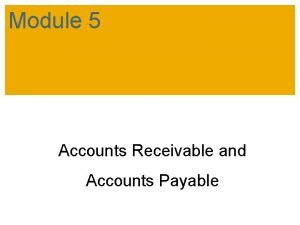Machine Learning for National Economic Accounts Jeff Chen































- Slides: 31

Machine Learning for National Economic Accounts Jeff Chen, Abe Dunn, Kyle Hood, Alex Driessen and Andrea Batch

Motivation End of Quarter Advance Estimate When we’d like it to be available Second Estimate When source data are available 2

Motivation End of Quarter Advance Estimate Second Estimate Short-term prediction using machine learning (for services sector estimates) Traditional Data Alternative Data 3

Possibilities: ML for National Economic Accounts 2 1 3 § Identify which modeling considerations (e. g. algorithm, data, feature selection) are associated with accuracy gains by PCE services component. § Construct ‘hurricane tracks’ for projected quarterly economic growth to help build consensus that a predicted growth is likely. M 1 vs. M 2 § Develop a simple framework for evaluating tradeoffs in terms of revision reductions relative to current methods. 4

Hurdles: There are more variables than records. Issue Solution Traditional statistical methods have trouble with k > n Id Y X 1 X 2 X 3 X 4 X 5 . . . x 999 Many ML methods can efficiently sift through inputs that maximize predictive accuracy. Id 1 1 2 2 3 3 . . 29 29 Which variables to choose? ! Y X 1 3 X 2 X 3 X 4 X 5 . . . x 999 1 2 Ranked 5

Hurdles: Small samples call for different strategies. Issue Typical goal of prediction is to crown a definitive winner among all tested models. Solution For national accounts, the ideal is to find a general set of approaches that will consistently yield accuracy gains. M 1 M 2 Algorithm 3 Algorithm 1 0 RMSE (While M 1 is better than M 2, in small samples there is effectively no difference) 0 RMSE (If M 1 and M 2 are derived from the same algorithm but with different inputs, we can form a strategy around a class of algorithm) 6

Hurdles: Predictions must beat current methods. Absolute accuracy of a model is important, but it needs to be contextualized in terms of national economic accounts. HOME GUEST 7

Approach (Part 1): A Prediction Horse Race Evaluate Absolute Performance Prediction Horse Race 1 2 Identify Best Relative Reductions 3 Predict the Quarterly Services Survey (QSS). 8

Step 1: A Prediction Horse Race 9

Step 1: Data in Horse Race Draw on a broad range of potential source data to compare traditional sources and alternative sources. Quarterly Services Survey U. S. Census Bureau 188 industry series n = 31 quarters Source data for significant proportion of PCE Services Credit Card Transactions First Data – Palantir/ Fed Board Revised Series 192 industries Lagged QSS U. S. Census Bureau 188 industry codes lagged for t-4 to t-1 Search Queries Google Trends 230 associated searches Current Employment Survey BLS 140 industries Consumer Price Index BLS 600+ indexes 10 10/28/2020

Step 1: Variable Selection Procedures in Horse Race Cherry Picking Kitchen Sink Include only conceptually similar variables. All-in. 25 data set combinations 11 10/28/2020

Step 1: Algorithms in Horse Race 4 Q Moving Average Ridge Regression Extreme Gradient Boosting Stepwise Regression CART Support Vector Machines LASSO Regression Random Forest Multi-Adaptive Regression Splines 12 10/28/2020

Step 1: Algorithms in Horse Race 4 Q Moving Average Ridge Regression Extreme Gradient Boosting Type of Method Univariate Stepwise Regression LASSO Regression CART Random Forest Support Vector Machines Multivariate Regression Non-Linear or Non-Parametric Multi-Adaptive Regression Splines 13 10/28/2020

Step 1: Algorithms in Horse Race 4 Q Moving Average Ridge Regression Extreme Gradient Boosting Interpretation Linear Interpretation Stepwise Regression LASSO Regression CART Random Forest Support Vector Machines Other Interpretation None Multi-Adaptive Regression Splines 14 10/28/2020

Step 1: Algorithms in Horse Race 4 Q Moving Average Ridge Regression Extreme Gradient Boosting Single or Ensemble (many in one) Single Stepwise Regression LASSO Regression CART Random Forest Support Vector Machines Ensemble Multi-Adaptive Regression Splines 15 10/28/2020

Methods: A Prediction Horse Race Test Train For Later Iterations 1 Iteration For Later Iterations Test Train 2 3 4 5 6 7 t-5 t-4 t-3 t-2 t-1 t t+1 t+2 t+3 t+4 t+5 Time 16

Methods: A Prediction Horse Race 886, 608 models were trained, based on the combinations of industry x data sets x algorithm x variable selection x time period 17

Prediction tracks show persistent a growth pattern is considering many different modeling scenarios. 18 10/28/2020

Some algorithms are more flexible in accounting for different ways of integrating information. NAICS 6211: Physician Offices 19 10/28/2020

Approach (Part 2): A Prediction Horse Race Evaluate Absolute Performance Prediction Horse Race 1 2 Identify Best Relative Reductions 3 Measure what generally leads to an accuracy increase in the QSS 20

Step 2: Average Absolute Accuracy Estimate a fixed-effects regression to parse out the average accuracy gain associated with each algorithm, data set, etc. 21

Results: Average RMSE Improvement (Algorithms) 0. 56 0. 43 0. 16 0. 00 -0. 04 -0. 25 -0. 68 -1. 48 -2. 15 Random Forest XGBoost LASSO Stepwise Regression Ridge SVM Decision Trees MARS Moving Average 22 10/28/2020

Results: Average RMSE Improvement (Data) 0. 97 0. 81 0. 39 0. 00 BLS CES Dependent Lags First Data BLS CPI Google Trends 23 10/28/2020

Methods: A Prediction Horse Race Evaluate Absolute Performance Prediction Horse Race 1 2 Identify Best Relative Reductions 3 Convert QSS into PCE and find sure-fire improvements compared with current 24

Step 3: Calculate Average Dollar Reduction in Revisions 1 Convert QSS into predictions of PCE services components 2 Calculate on average revision if prediction is used 3 Calculate on revision reduction relative to current methods 25

Physician Services: High Chance of Revision Reduction 26 10/28/2020

Physician Services: High Chance of Revision Reduction 27 10/28/2020

vs. Stepwise regression is 25% less likely to yield a revision reduction to physician services when compared with the best method. 28 10/28/2020

Non Profit Hospitals: Less Useful Result 29 10/28/2020

Next Steps Construct a “moneyball” set of algorithms that yield marked wins for the home team. 30

Jeffrey. Chen@bea. gov
 Chen chen berlin
Chen chen berlin Concept learning task in machine learning
Concept learning task in machine learning Analytical learning in machine learning
Analytical learning in machine learning Pac learning model in machine learning
Pac learning model in machine learning Machine learning t mitchell
Machine learning t mitchell Inductive and analytical learning in machine learning
Inductive and analytical learning in machine learning Deductive learning vs inductive learning
Deductive learning vs inductive learning Instance based learning in machine learning
Instance based learning in machine learning Inductive learning machine learning
Inductive learning machine learning First order rule learning in machine learning
First order rule learning in machine learning Eager learning vs lazy learning
Eager learning vs lazy learning Deep learning vs machine learning
Deep learning vs machine learning Cuadro comparativo e-learning y b-learning
Cuadro comparativo e-learning y b-learning Skypak hvac replacement
Skypak hvac replacement The national income and product accounts
The national income and product accounts National account systems
National account systems System of national accounts (sna)
System of national accounts (sna) Advisory expert group on national accounts
Advisory expert group on national accounts Jeff heaton github
Jeff heaton github Economic growth vs economic development
Economic growth vs economic development Difference between economic growth and economic development
Difference between economic growth and economic development Lesson 2 our economic choices
Lesson 2 our economic choices National council for economic education
National council for economic education Fspos
Fspos Novell typiska drag
Novell typiska drag Nationell inriktning för artificiell intelligens
Nationell inriktning för artificiell intelligens Ekologiskt fotavtryck
Ekologiskt fotavtryck Varför kallas perioden 1918-1939 för mellankrigstiden?
Varför kallas perioden 1918-1939 för mellankrigstiden? En lathund för arbete med kontinuitetshantering
En lathund för arbete med kontinuitetshantering Personalliggare bygg undantag
Personalliggare bygg undantag Tidbok
Tidbok Sura för anatom
Sura för anatom
